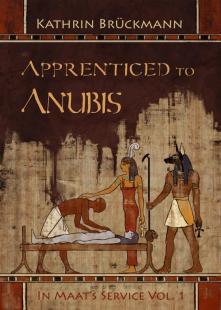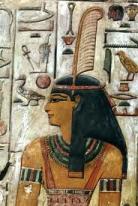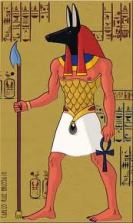 Here’s a murder mystery with a different twist. It’s set in ancient Egypt, in the reign of Pharaoh Senusret III, whose dates are 1878 BC to 1839 BC, which was a time of great power and prosperity. Pharaoh Senusret III was the fifth monarch of the Twelfth Dynasty of the Middle Kingdom. He was the one who achieved the building of the Canal of the Pharaohs, and was one of the few kings who were deified and honored with a cult during their own lifetime. If you care.
Here’s a murder mystery with a different twist. It’s set in ancient Egypt, in the reign of Pharaoh Senusret III, whose dates are 1878 BC to 1839 BC, which was a time of great power and prosperity. Pharaoh Senusret III was the fifth monarch of the Twelfth Dynasty of the Middle Kingdom. He was the one who achieved the building of the Canal of the Pharaohs, and was one of the few kings who were deified and honored with a cult during their own lifetime. If you care.
I could have just read through this book and enjoyed it, but I doubly enjoyed it because I looked up all the stuff I didn’t know about this time. Which was pretty much everything. Like Maat. The series is apparently called In Maat’s Service. Well, la di dah. Who is Maat? Yeah, well, who is Anubis for that matter? Google to the rescue!
Let’s start with Maat, because she is involved in the story. Sometimes it’s spelled Ma’at. (What are we supposed to do with those apostrophes in the middle of vowels? How do you pronounce an apostrophe?) Well, never mind, moving on. Maat, or Mayet, or Maae’t or māt or mayet, was the ancient Egyptian concept of truth, balance, order, law, morality, and justice. Maat was also personified as a goddess regulating the stars, seasons, and the actions of both mortals and the deities, who set the order of the universe from chaos at the moment of creation. (Thanks Wiki.)
Maat represents the ethical and moral principle that every Egyptian citizen was expected to follow throughout their daily lives. They were expected to act with honor and truth in manners that involve family, the community, the nation, the environment, and god. The King would describe himself as the “Lord of Maat” who decreed with his mouth the Maat he conceived in his heart.
Maat was usually represented as a young woman, sitting or standing, holding a was scepter, the symbol of power, in one hand and an ankh, the symbol of eternal life, in the other. Sometimes she is depicted with wings on each arm or as a woman with an ostrich feather on her head.
In the Egyptian underworld, the hearts of the dead were said to be weighed against her single “Feather of Ma’at”, symbolically representing the concept of Maat, in the Hall of Two Truths. This is why hearts were left in Egyptian mummies while their other organs were removed, as the heart was seen as part of the Egyptian soul. If the heart was found to be lighter or equal in weight to the feather of Maat, the deceased had led a virtuous life and would go on to Aaru. Here she is:


Now for Anubis, in whose service our protagonist is placed. Anubisis is the Greek name of a jackal-headed god associated with mummification and the afterlife in ancient  Egyptian religion. He attended the weighing scale during the “Weighing of the Heart.” He was depicted in black, a color that symbolized both rebirth and the discoloration of the corpse after embalming. Later on he seems to have been combined with Wepwawet (also called Upuaut), another Egyptian god portrayed with a dog’s head or in canine form.
Egyptian religion. He attended the weighing scale during the “Weighing of the Heart.” He was depicted in black, a color that symbolized both rebirth and the discoloration of the corpse after embalming. Later on he seems to have been combined with Wepwawet (also called Upuaut), another Egyptian god portrayed with a dog’s head or in canine form.
Like many ancient Egyptian deities, Anubis assumed different roles in various contexts. Depicted as a protector of graves as early as the First Dynasty (c. 3100 – c. 2890 BC), Anubis was also an embalmer. This is Anubis on the left. Looks kinda like a Doberman Pinscher.
Now, why are we interested in Maat and Anubis? Because our protagonist, young Hori has just finished his training as a doctor, and passes the oral exam. After a celebratory party held by the son of the Vizier, they all go off to a bar, where the son of the Vizier tries to molest a young serving girl. Hori, being the dutiful follower of Maat that he is, tries to prevent further abuse, knocking the guy, who trips and falls, hitting his head and dying. The father, being quite powerful, tries to bribe witnesses to claim that Hori deliberately killed the youth. Fortunately, enough witnesses tell the truth, and the young Pharaoh Senusret has to walk a fine line here between justice and the wishes of his Vizier. Instead of condemning Hori to death, or to a life sentences in the stone pit, (pretty much the same thing), he sentences him to life in The House of Death, the weryt, an intensely secret place on an island where the dead are brought, cleaned, and embalmed. However, this means that although Hori is allowed to live, he can never leave the weryt, and it would cause his death to reveal any of the secrets from there to anyone outside the weryt.
It is during his work here that young Dr. Hori discovers that several young girls who end up on his embalming table have the same kind of puncture wound. He sees a pattern, and believes they have been murdered. But by who? And why? And so begins our tale.
A good mystery woven throughout with the thoroughly researched details of life in that time in ancient Egypt. You may learn just a bit more about the embalming practices of the Egyptians that perhaps you quite wanted to, but I loved it. So all in all, the book has all the elements that I like in historical mystery fiction: a feeling of authenticity of the period, a decent mystery, some likable characters that we can cheer for, and enough detail that I can learn something new.
Kathrin Brückmann is a German writer, living in Berlin, and the original is in German, so we must give due kudos to the fine translation of Edith Parzefall. I believe further adventures of Doctor Hori and his best friend, Doctor Nakhtmin are planned. I certainly look forward to reading them.
 A detective mystery featuring an insufferably supercilious and condescending professor of criminology and his somewhat timid student/assistant, who he is privately coming to think is terribly clever and perspective, but whom I think is just sensible. He is apparently called on by the police to help out in various homicide investigations where the police are dumbfounded. Kind of like Sherlock Holmes — same smugness and superiority without the charm. OK, Sherlock Holmes had no charm either. He, too, was insufferably supercilious and condescending.
A detective mystery featuring an insufferably supercilious and condescending professor of criminology and his somewhat timid student/assistant, who he is privately coming to think is terribly clever and perspective, but whom I think is just sensible. He is apparently called on by the police to help out in various homicide investigations where the police are dumbfounded. Kind of like Sherlock Holmes — same smugness and superiority without the charm. OK, Sherlock Holmes had no charm either. He, too, was insufferably supercilious and condescending.










